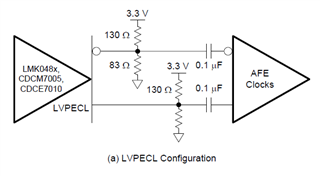Other Parts Discussed in Thread: AFE5818,
Dear Sir or Madam,
I am trying to figure out whether I need a far end or near end termination for the sampling CLK.
According to the Eval Board the termination seems to be at the transformer side. This suggests some low impedance input on pins 59,58.
For what wave impedance are the diff. traces on the eval board routed for?
Thank you for all your help.
Best Regards,



